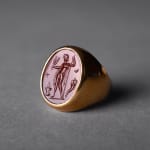Carnelian Intaglio with Figure of a Young Man or Deity, 1700 CE - 1800 CE
Carnelian/Gold
FJ.5633
Further images
The art of glyptics, or carving on colored precious stones, is probably one of the oldest known to humanity. Intaglios, gems with an incised design, were made as early as...
The art of glyptics, or carving on colored precious stones, is probably one of the oldest known to humanity. Intaglios, gems with an incised design, were made as early as the fourth and third millennnia BC in Mesopotamia and the Aegean Islands. They display a virtuosity of execution that suggests an old and stable tradition rooted in the earliest centuries. The tools required for carving gems were simple: a wheel with a belt-drive and a set of drills. Abrasives were neccessary since the minerals were too hard for a metal edge. A special difficulty of engraving intaglios, aside from their miniature size, was that the master had to work with a mirror-image in mind. Carnelian was one of the most popular stones for engraving in the Classical Revival, due to its rich red color which contrasts so beautifully with gold. The connoisseurs of the 18th. Century delighted in images and scenes which harkened back to the 'Arcadian' paradise of Greek myths and legends. This exquisite intaglio shows a standing naked youth holding a spear and two palm branches. Surrounding him is a cornucopia (symbol of fortune), a brazier spewing fire, crescent moon and star. Thus we see symbols for prosperity, paradise and spirit, revolving on a background of fire, symbol of life and health. With such propitious emblems, this ring will surely bring good luck to its new owner.





